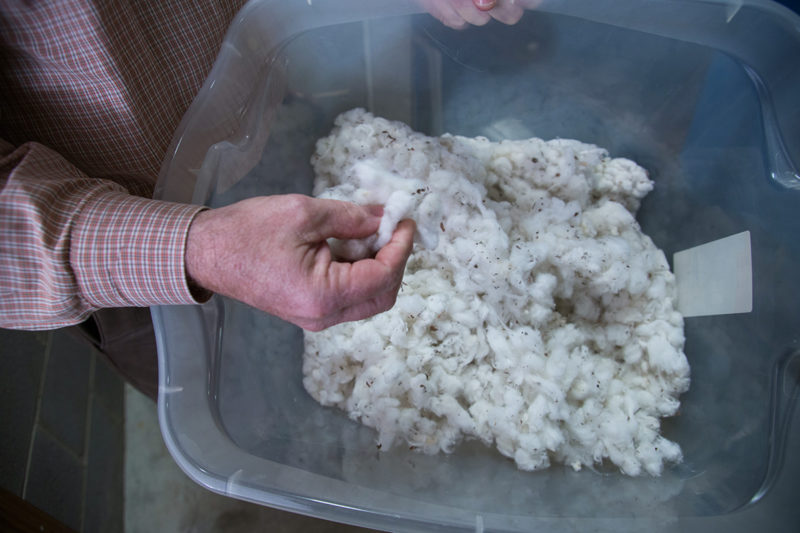A Bumper Crop for Texas Cotton Could Spell Trouble for Farmers
By Stephen Cabler
Reporting Texas

The Texas Cotton Ginners’ Association has been helping cotton farmers since the 1800s with regulations to keep the industry bustling. The association broke up once in the early days over barrel shape and reconvened in 1907. Cristina Pop/Reporting Texas
Texas cotton farmers’ prospects are uncertain as planting season approaches, with unsold crops from 2018 sitting in storage and a shaky global economy undermining demand. Conditions seem promising for a good growing season in 2019, which could put more downward pressure on already slipping prices.
With economists predicting an economic slowdown for the United States in 2019, trade relations with China as volatile as ever and big importers of American goods not as active as they have been recently, many sectors of agriculture, including cotton, could be in danger of overproduction, leading to falling prices and hard times for farmers.
“I’m worried that we will have a very, very large crop,” said John Robinson, agriculture economist from Texas A&M University. “We’ll have a very large supply, which will be added to excess supplies and probably pressuring prices a lot.”
Texas is the largest producer of cotton in the United States. In 2017, the state produced almost 46 percent of domestic cotton, according to the USDA 2018 annual report. Because of high moisture levels and overall weather conditions, Texas grew 9.27 million of the 20.2 million bales of cotton produced in the U.S., according to the USDA. From 2013 to 2017, average production was 6.7 million bales.
Texas Farmers harvested 5.5 million of the 6.9 million acres planted in 2017, an increase from any of the previous five years, according to the same USDA report. This large yield contributed to the glut farmers face today, and with a bumper crop forecast, prices could take a hit.

Member and director of technical services for the Texas Cotton Ginners’ Association, J. Kelley Green, stores buckets at the Texas Cotton Ginners’ Association in Austin. The cotton is used for demonstrations during classes for kids about the cotton production process. “I just like the education,” Green said. Cristina Pop/Reporting Texas
Global economic conditions play a big role in cotton prices, and economists are speculating that we will see a worldwide economic slowdown, “partly because of the negative effects of tariff increases enacted in the United States and China,” according to the International Monetary Fund.
The U.S. exported nearly 16 million bales of cotton in 2017 and is projected to send abroad just under that number in 2018, according to the USDA cotton report for 2018. Buyers in countries like Vietnam (22 percent), China (12 percent) and Turkey (13 percent) import almost half of the U.S. cotton exports combined, according to IHS Markit.
The United States is at odds with two of the three largest importers of domestic cotton.
China has levied tariffs on U.S. cotton in response to U.S. tariffs on various Chinese exports; the two are engaged in trade talks that could defuse the issue. At the same time, tariffs on steel and aluminum have aggravated problems with the Turkish economy and currency, leading to a slowdown in cotton demand there.
“They’re not being the big customer they usually are,” Robinson said. Against this troubling international outlook, conditions look good for another great growing season in 2019. High moisture this past fall augurs high yields for Texas cotton farmers.

J. Kelley Green, director of technical services, takes apart a cotton gin to demonstrate how the water-powered machine separates the seed from hull. The cotton gin from the 1800s was refurbished in Prattville, Ala., and transported to the Texas Cotton Ginners’ Association after their reunion in 1907. Cristina Pop/Reporting Texas
Robinson said U.S. farmers could be looking at a 21-million-bale crop, up over a million bales from the estimated 19.8 million-bale crop in 2018. With growers already having excess amounts of cotton, another high-yield season would lead to more unsold cotton and drive prices even further down, to 60 cents a bale, Robinson said.
“When you see a drop in commodity prices, it has a huge impact on (the farmers) bottom line,” Donna Mitchell McCallister, a research assistant professor in agricultural and applied economics at Texas Tech University, said.
Large cotton farms need money to start their production, so farmers “borrow hundreds of thousands of dollars to grow this crop,” Robinson said. When cotton sells below its average, farmers don’t bring in a profit and cannot repay their loans.
“A producer cannot be sustainable in the long run of they are not profitable,” McCallister said. “So those changing prices really do have a huge impact on their ability to survive.”
Even with the favorable weather predictions for cotton this season conditions can be unpredictable. High winds, hail and drought are all factors that could play into cotton season.
“The one thing we can’t predict is what the weather is going to actually do,” McCallister said. “It usually has a way of throwing a monkey wrench into all of our plans.”